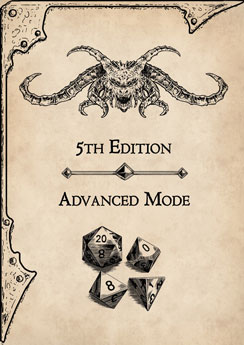Large beast (dinosaur), unaligned
Armor Class 13 (natural armor)
Hit Points 68 (8d10 + 24)
Speed 30 ft.
Proficiency Bonus +2
Proficiency Bonus +4 (5th Edition Advanced Mode)
| STR | DEX | CON | INT | WIS | CHA |
|---|---|---|---|---|---|
| 18 (+4) | 10 (+0) | 16 (+3x) | 2 (-4) | 12 (+1) | 5 (-3) |
Senses passive Perception 11
Languages –
Challenge 3 (700 XP)
Trampling Charge. If the Monoclonius moves at least 20 feet straight toward a creature and then hits it with a ram attack on the same turn, that target must succeed on a DC 14 Strength saving throw or be knocked prone. If the target is prone, the Monoclonius can make one stomp attack against it as a bonus action.
ACTIONS
- Ram. Melee Weapon Attack: +6 to hit, reach 5 ft., one target. Hit: 15 (2d10 + 4) bludgeoning damage.
- Stomp. Melee Weapon Attack: +6 to hit, reach 5 ft., one prone creature. Hit: 17 (2d12 + 4) bludgeoning damage.
5th Edition Advanced Mode
Limiting the power of a character and making the overall difficulty of the game harder, does not reduce the creativity, indeed it does quite the opposite.
The Game Master has the option to use any and all of the instances proposed in this guide, or just some of them according to their preference.
It is the lack of something that move and motivate characters, not the abundance of it
DESCRIPTION
The Monoclonius, also known as the onehorn in the jungles of Malatra, is a species of dinosaur that bears a striking resemblance to the triceratops, but with a distinctive difference—it possesses only a single horn above its snout. This majestic creature is protected by a thick, bony head crest and has very thick skin, which serves as armor against predators. Its head is notably flexible, allowing for rapid movement and responsiveness.
COMBAT
In the realm of combat, the Monoclonius’s horn is not just for show—it’s a strong and sharp natural weapon. The creature’s thick skin is resilient enough to fend off all but the sharpest claws. When faced with smaller predators, a herd of Monoclonius may choose to simply stampede over them, using their sheer size and strength to their advantage.
HABITAT / SOCIETY
Monoclonius dinosaurs are known to inhabit the lush and dangerous jungles of Chult. They live in herds, which suggests a level of social structure and mutual protection. At one point in history, Chultan dwarves even trained a pair of Monoclonius to act as beasts of burden, showcasing the creatures’ versatility and the possibility of a symbiotic relationship with other species.
ECOLOGY
As herbivores, Monoclonius feed on the abundant plant life of their habitats. Their presence within an ecosystem plays a crucial role in the balance of nature, as they likely aid in the dispersal of seeds and the maintenance of vegetation. The herding behavior of Monoclonius also indicates a complex ecology where these creatures not only interact with their environment but also with each other.
